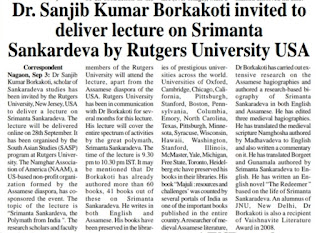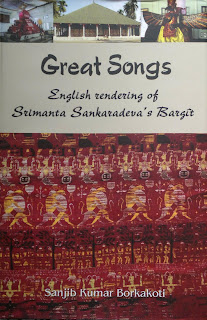Lecture on Srimanta Sankaradeva at Rutgers University, New Jersey, USA
A special event of 2021 was my online lecture at Rutgers University, New Jersey, USA. It was held on 28th September 2021. Preparation for it was started from six months earlier.
Title of my lecture was “Srimanta Sankaradeva, the Polymath from India.” It was organised by the South Asian Studies Program (SASP) at Rutgers University and was co-sponsored by the Naamghar Association of America (NAAM). Dr. Julia Stephens, Interim Director of SASP welcomed me and the audience at the outset. Dr. Sanjib Bhuyan, an Executive Committee member of SASP and a faculty member at Rutgers University gave a brief introduction about me.
I began my lecture with an idea about the social reform brought about by Srimanta Sankardeva. I elaborated how the caste differences and class differences were done away with by the saint. I highlighted the educational activities, especially the works in the area of adult education and non-formal education. I spoke about the thrust given by the saint on education of women and those in the lowest echelon of the society. I likened the saint to lord Buddha in that both gave up royal status to come down to the level of the commoners. I mentioned the special status accorded to women by the saint in the order. I talked about the Thân or Satra institution and its multifaceted features. I said that Thân or Satra is similar to Kibbutz and Commune in terms of the set up. I highlighted the work culture of this institution. I also discussed the special architecture of the Kirtanghar, the central component of Thân or Satra, as different from other Hindu temples. Photos of the Kirtanghar and the Guru Asan inside it were shown in the presentation. How people sat together irrespective of caste or gender inside the Kirtanghar was highlighted in the lecture, with photographic evidence. The cultural aspect of the Kirtanghar was also discussed. I talked about Bhaona and showed the beautiful Aharya used in it.
I also spoke about manuscript preparation and painting. I said that the special features of the manuscript writing taught by the saint has made the medieval manuscripts to last till now, with the glaze of the writings as bright as before. I also showed slide with posture of Sattriya dance and described the 25 Ragas created by the great saint. The history of Chihna Yatra was mentioned in the lecture. I highlighted the fact that the impact of the saint litterateur has continued even five centuries later. The Assamese society is free of many social evils because of his influence. Women are given prominence in his order. The Sattriya dance and Bargeet created by him have acquired special status among cultural experts because of their classical characters. I explained the use of metaphors in the Bhaona performance. The attendees included several from India as well as many from the Assamese diaspora in America. Among the attendees, Dr. Binoy Bordoloi, President of NAAM was also present.
Among the persons who asked me questions were Pulitzer prize winner Sanghamitra Kalita, Vice President of ICOMOS Dr Rima Hooja etc. The event was given nice coverage in print media.






-1.jpg)
Comments
Post a Comment
You are welcome to place your comment here :